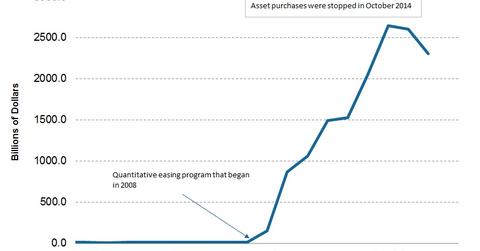Will the Fed’s Balance Sheet Rebalancing Act Disrupt the Markets?
In Rosengren’s view, the markets can absorb the rebalancing of the Fed’s balance sheet only if the entire process is done gradually.
May 11 2017, Published 2:29 p.m. ET

Rosengren is in favor of balance sheet shrinking
In his recent speech at the New York University Stern School of Business on May 9, 2017, Eric Rosengren, president of the Federal Reserve Bank of Boston, broached the subject of the Fed balance sheet rebalancing. We first heard about it in the minutes of the FOMC (Federal Open Market Committee) meeting on May 2–3, 2017. In Rosengren’s view, the markets can absorb the rebalancing of the Fed’s balance sheet only if the entire process is done gradually.
He admitted that the discussion among Fed members is still in its nascent state, and they’re still working on a strategy to rebalance the Fed’s balance sheet. He hoped the process of normalizing the balance sheet will begin soon. He expects it to be a gradual and steady move to reach the desired levels, which could reduce its size by close to 50.0% from its current levels.
Impact of balance sheet shrinking
When the Fed decides to reduce the size of its balance sheet, which currently holds bonds worth $4.4 trillion, it’s likely to increase the supply of bonds in the fixed income markets (HYG). The Fed would slowly offload the large cache of bonds (MBB) and government securities (SHY) in its portfolio.
To know more about the Fed’s balance sheet, read Inside the Fed’s Balance Sheet (The biggest in the World).
Esther George supports balance sheet shrinking
Esther George, president of the Federal Reserve Bank of Kansas City, said in a May 9, 2017, speech that the Fed should reduce the side of its balance sheet and begin doing so this year. She indicated that the process should begin by reducing the Fed’s investments in longer-term Treasuries (TLT) and mortgage-backed securities (LMBS). Then it should move toward setting the process on “autopilot’ mode. She also supports a gradual increase in US interest rates.
